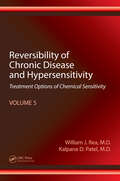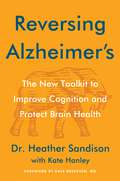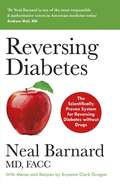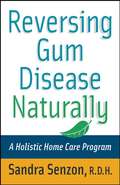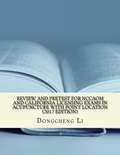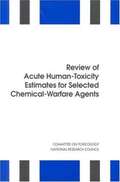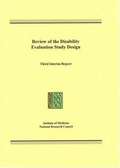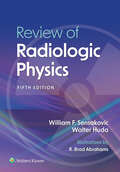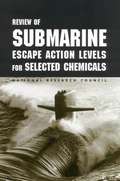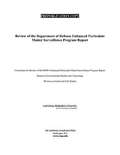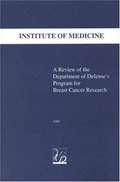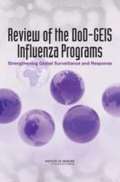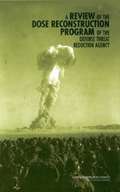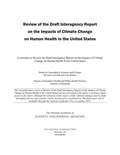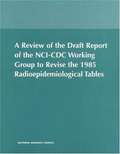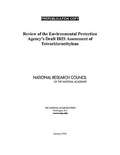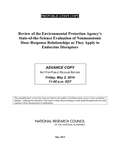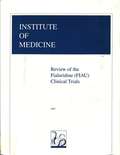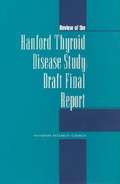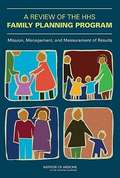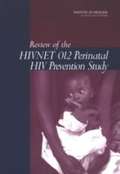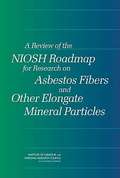- Table View
- List View
Reversibility of Chronic Disease and Hypersensitivity, Volume 5: Treatment Options of Chemical Sensitivity
by William J. Rea Kalpana D. PatelThe clinical approaches to the chronic degenerative diseases that drain our resources, and compromise our well-being, have become almost exclusively symptom-focused. The common wisdom is that they are idiopathic with final outcomes to be managed rather than prevented or cured. That they are potentially reversible rarely enters any discussion between doctor and patient. Reversibility of Chronic Disease and Hypersensitivity, Volume 5: Treatment Options of Chemical Sensitivity, the final volume of this set, offers a much different perspective on chronic degenerative disease; one that disputes the idiopathic label attached to most, as well as the usual fatalistic prognosis.
Reversing Alzheimer's: The New Toolkit to Improve Cognition and Protect Brain Health
by Heather SandisonA revolutionary and much-needed exploration of Alzheimer’s and how patients and their caregivers can take back control from this insidious disease.A significant portion of our population worries about the grip of dementia as we age. With over 6.5 million Americans living with Alzheimer's, the urgency for a solution has never been greater.Dr. Heather Sandison is at the forefront of dementia care and research. The founder of Solcere Health Clinic, San Diego’s premier brain optimization clinic, and Marama, the first residential memory care facility to have the goal of returning cognitively declined residents to independent living, Dr. Sandison knows better than most what Alzheimer’s does to people—to their brains, their bodies, their families, and their lives.If you're facing the challenge of Alzheimer's, either personally or as a caregiver, there is hope. A growing body of evidence shows that implementing a handful of strategies can improve cognition and quality of life in dementia patients. In Reversing Alzheimer's, Dr. Sandison lays out this customizable and doable approach so that you can start supporting you or your loved one's brain health right away.Within these pages, Dr. Sandison distills complex neurocognitive research into actionable steps, empowering you to:Fortify your brain health against cognitive declineImplement lifestyle changes that can reverse the effects of Alzheimer'sTransform your environment to support cognitive wellnessUnderstand options for brain health to fit any budgetDr. Sandison's expertise, derived from her clinical practice, residential care, and peer-reviewed research, charts the course for a future where Alzheimer's is not a terminal diagnosis, but a reversible condition. Reversing Alzheimer’s is an essential tool for anyone aspiring to rewrite their story and achieve a future free from the affliction of Alzheimer's.
Reversing Diabetes: The Scientifically Proven System for Reversing Diabetes without Drugs
by Dr Neal BarnardTackle diabetes and its complications for good with this newly updated edition of Dr. Neal Barnard's groundbreaking program.Revised and updated, this latest edition of Dr. Barnard's revolutionary guide to controlling your blood sugar features a new preface, updates to diagnostic and monitoring standards, recent research studies, and fresh success stories of people who have eliminated their diabetes by following this life-changing plan.Before Dr Barnard's scientific breakthrough (which predates almost every other book on blood sugar control), most health professionals believed that once you developed diabetes, you were stuck with it - and could anticipate one health issue after another, from worsening eyesight and nerve symptoms to heart and kidney problems. We know now that this is simply not true.Dr. Barnard has shown that it is possible to improve insulin sensitivity and tackle type 2 diabetes by following his step-by-step plan, which includes: ¦ a healthful vegan diet with plenty of recipes to get started¦ an easy-to-follow exercise guide¦ advice about taking supplements and tracking progress¦ troubleshooting tips¦ and more!It's a proven, tried and tested way to treat diabetes. And it's about time.
Reversing Gum Disease Naturally: A Holistic Home Care Program
by Sandra SenzonGum disease is the #1 oral health issue for Americans today-and simply brushing and flossing are not enough to avoid it. In this unique book, registered dental hygienist Sandra Senzon reveals how you can prevent and reverse gum disease through natural treatments. You'll get a new and broader understanding of your mouth as Senzon explains the causes of gum disease, along with the roles that stress, diet, and certain conditions such as diabetes can play in the onset of the disease. She shows you how to work with holistic products, set up an at-home hygiene center, and find the right professional to guide you in the natural reversal of gum disease. There's even a section for parents on how to help children practice good oral hygiene. Packed with expert tips and motivational strategies, Reversing Gum Disease Naturally will enable you to keep your gums and your teeth healthy and strong.
Review And Pretest For Nccaom And California Licensing Exams In Acupuncture With Point Location
by Dongcheng LiThis book is intended to aid students preparing for the National Certification Commission for Acupuncture and Oriental Medicine (NCCAOM) in Acupuncture with Point Locations module and, the California Acupuncture Licensing Examination. It is a concise review of Acupuncture and is intended to help the student recall material taught during the first and second years of Acupuncture school. It is not intended to substitute for comprehensive textbooks. The material is organized and divided into eight chapters. It will cover an Introduction to Acupuncture, the Twelve Primary Meridians and Their Acupoints, Eight Extra Meridians and Their Acupoints, Divergent Channels, Muscular-Sinew channels, Cutaneous Regions, Luo-connecting channels, Auricular and Scalp Acupuncture, Acupuncture Techniques, Acupuncture Treatment, Cautions of Acupoints, Regulations of States and NCCAOM, and Practice-related Issues. The knowledge points are summarized by words, concisely and clearly, with appropriate charts or pictures attached. Numerous practice questions reflecting the content and format of NCCAOM exam in Acupuncture with Point Location module are included after each chapter and six comprehensive examinations at the end of the book. These questions can be used as a pretest to identify areas of weakness or as a post test to determine mastery.
Review of Acute Human-Toxicity Estimates for Selected Chemical-Warfare Agents
by Subcommittee on Toxicity Values for Selected Nerve Vesicant AgentsA Review of Acute Human-Toxicity Estimates for Selected Chemical-Warfare Agents
A Review of Biomaterials and Their Applications in Drug Delivery (SpringerBriefs in Applied Sciences and Technology)
by Hamid Reza Rezaie Mohammadhossein Esnaashary Abolfazl Aref Arjmand Andreas ÖchsnerThis book reviews drug delivery systems as mechanisms to introduce therapeutic agents into the body to help or improve tissue function, and examines different drug delivery systems applied in various organs. To date, polymeric systems, ceramic particles or composites have been used in different applications such as injectable, coatings of implants, scaffolds, or implantable devices. Such systems should be able to retain the therapeutic agent and release it in uniform amounts at a specific time.
Review of Disability Evaluation Study Design: Third Interim Report
by Committee to Review the Social Security Administration's Disability Decision Process ResearchThe National Academies Press (NAP)--publisher for the National Academies--publishes more than 200 books a year offering the most authoritative views, definitive information, and groundbreaking recommendations on a wide range of topics in science, engineering, and health. Our books are unique in that they are authored by the nation's leading experts in every scientific field.
Review of Radiologic Physics
by William SensakovicOffering a complete review for radiology residents and radiologic technologists preparing for certification, Review of Radiologic Physics, 5th Edition, by Dr. William F. Sensakovic, is a high-yield, efficient resource for today’s clinically focused exams. Now fully up to date, this edition covers x-ray production and interactions, projection and tomographic imaging, image quality, radiobiology, radiation protection, nuclear medicine, ultrasound, and magnetic resonance—all of the important physics information you need to understand the factors that improve or degrade image quality.
Review of Rheumatology
by Nona T. ColburnReview of Rheumatology is a synopsis of key areas of interest, making for an indispensable quick reference work. The material included reviews basic musculoskeletal anatomy, immunology, genetics, major rheumatic diseases and their pathophysiology, and major rheumatic therapeutics, as well as a unique chapter on the emerging autoinflammatory diseases. Review of Rheumatology is a clear and concise review book written in an outline format. This book is a quick and easily accessible reference not only for those preparing for the rheumatology board exams, but it also serves as a succinct reference for all health care workers interested in the field of rheumatology.
Review Of Submarine Escape Action Levels For Selected Chemicals
by Subcommittee on Submarine Escape Action LevelsThe National Academies Press (NAP)--publisher for the National Academies--publishes more than 200 books a year offering the most authoritative views, definitive information, and groundbreaking recommendations on a wide range of topics in science, engineering, and health. Our books are unique in that they are authored by the nation's leading experts in every scientific field.
Review of the Department of Defense Enhanced Particulate Matter Surveillance Program Report
by National Research Council of the National AcademiesSoldiers deployed during the 1991 Persian Gulf War were exposed to high concentrations of particulate matter (PM) and other airborne pollutants. Their exposures were largely the result of daily windblown dust, dust storms, and smoke from oil fires. On returning from deployment, many veterans complained of persistent respiratory symptoms. With the renewed activity in the Middle East over the last few years, deployed military personnel are again exposed to dust storms and daily windblown dust in addition to other types of PM, such as diesel exhaust and particles from open-pit burning. On the basis of the high concentrations observed and concerns about the potential health effects, DOD designed and implemented a study to characterize and quantify the PM in the ambient environment at 15 sites in the Middle East. The endeavor is known as the DOD Enhanced Particulate Matter Surveillance Program (EPMSP). The U.S. Army asked the National Research Council to review the EPMSP report. In response, the present evaluation considers the potential acute and chronic health implications on the basis of information presented in the report. It also considers epidemiologic and health-surveillance data collected by the USACHPPM, to assess potential health implications for deployed personnel, and recommends methods for reducing or characterizing health risks.
A Review of the Department of Defense's Program for Breast Cancer Research
by Committee to Review the Department of Defense's Breast Cancer Research ProgramAccording to current statistical data, one in eight women will be diagnosed with breast cancer. The five-year survival rate for breast cancer patients has improved in recent years, but the overall mortality rates have changed little. In 1993 Congress allocated $210 million for breast cancer research as part of the Department of Defense budget. An Institute of Medicine (IOM) committee was convened at that time to advise the U.S. Army Medical Research and Development Command on strategies for managing a breast cancer research program. This book evaluates the program's management and achievements to date. Although it is too early to evaluate the program in terms of breakthrough results and new insights produced by the funded projects or investigators, this book documents the process used to select research proposals for funding and analyzes the portfolio of funded projects in terms of their responsiveness to the recommendations and fundamental questions articulated in the 1993 IOM report.
Review of the DoD-GEIS Influenza Programs: Strengthening Global Surveillance and Response
by Institute of Medicine of the National AcademiesThe National Academies Press (NAP)--publisher for the National Academies--publishes more than 200 books a year offering the most authoritative views, definitive information, and groundbreaking recommendations on a wide range of topics in science, engineering, and health. Our books are unique in that they are authored by the nation's leading experts in every scientific field.
A Review Of The Dose Reconstruction Program Of The Defense Threat Reduction Agency
by Committee to Review the Dose Reconstruction Program of the Defense Threat Reduction AgencyIn response to concerns about military personnel and civilian exposure to radiation from the US atmospheric nuclear weapons testing program of 1945-62, Congress charged an independent committee to review the Dose Reconstruction Program. This report details the testing program and the committee's review process, and offers recommendations for improving dose reconstruction and the overall veterans compensation program. Appendices include documents reviewed, names of hearing experts, names of veterans whose files were reviewed, analyses of participant exposure, and a glossary. The cover photo shows soldiers watching an atomic bomb detonation in 1951 in Nevada. Annotation ©2004 Book News, Inc. , Portland, OR (booknews. com)
Review of the Draft Interagency Report on the Impacts of Climate Change on Human Health in the United States
by National Academies of Science Engineering MedicineThe U.S. National Climate Assessment (NCA; Melillo et al., 2014) identified a number of ways in which climate change is affecting or is likely to affect, people, infrastructure, natural resources, and ecosystems. Those impacts in turn have the potential for important current and future consequences for human health. Research on these impacts is active, with strong evidence to support some aspects and research still in progress for others. Therefore, there is a need to assess our understanding of how the impacts of climate change on the environment can create stressors that can affect human health in a number of dimensions both now and in the future. <P> In response to this need, the U.S. Global Change Research Program (USGCRP) has initiated an interagency Assessment on the Impacts of Climate Change on Human Health in the United States. The Assessment is intended to inform public health authorities, other planning and policy entities, and the general public. It extends the work begun under the 2008 Synthesis and Assessment Product 4.6 (USGCRP, 2008) Analyses of the Effects of Global Change on Human Health and Welfare and Human Systems and the third NCA released in 2014.
A Review of the Draft Report of the NCI-CDC Working Group to Revise the 1985 Radioepidemiological Tables
by National Research CouncilThe review is an impressive document and covers many technical issues in a commendable fashion. ...for those who are involved in radiation risk assessment or compensation, the subcommittee report makes interesting reading and succinctly deals with a number of technical issues. ...I recommend this NAS report to all those who have an interest in this field and want to be further informed about the current problems taxing some of the world's top minds in this area.--Journal of Radiological Protection, June 2001
Review of the Environmental Protection Agency's Draft IRIS Assessment of Tetrachloroethylene
by National Research Council of the National AcademiesTetrachloroethylene is a volatile, chlorinated organic hydrocarbon that is widely used as a solvent in the dry-cleaning and textile-processing industries and as an agent for degreasing metal parts. It is an environmental contaminant that has been detected in the air, groundwater, surface waters, and soil. In June 2008, the U.S. Environmental Protection Agency released its draft Toxicological Review of Tetrachloroethylene (Perchloroethylene) (CAS No. 127-18-4) in Support of Summary Information on the Integrated Risk Information System (IRIS). The draft IRIS assessment provides quantitative estimates of cancer and noncancer effects of exposure to tetrachloreothylene, which will be used to establish airquality and water-quality standards to protect public health and to set cleanup standards for hazardous waste sites. At the request of EPA, the National Research Council conducted an independent scientific review of the draft IRIS assessment of tetrachloroethylene from toxicologic, epidemiologic, and human clinical perspectives. The resulting book evaluates the adequacy of the EPA assessment, the data and methods used for deriving the noncancer values for inhalation and oral exposures and the oral and inhalation cancer unit risks posed by tetrachloroethylene; evaluates whether the key studies underlying the draft IRIS assessment are of requisite quality, reliability, and relevance to support the derivation of the reference values and cancer risks; evaluates whether the uncertainties in EPA's risk assessment were adequately described and, where possible, quantified; and identifies research that could reduce the uncertainty in the current understanding of human health effects associated with tetrachloroethylene exposure.
Review of the Environmental Protection Agency's State-of-the-Science Evaluation of Nonmonotonic Dose-Response Relationships as they Apply to Endocrine Disruptors
by National Research Council of the National AcademiesPotential health effects of chemicals that disrupt endocrine function pose an environmental health concern about their ability to interfere with normal hormone function in human and wildlife populations. The endocrine system regulates biologic processes throughout the body and can be sensitive to small changes in hormone concentrations. Endocrine-disruptor research has focused primarily on chemicals that affect three hormone pathways that play important roles in reproduction and development—the estrogen, androgen, and thyroid hormone pathways. Some of the research has identified dose–response relationships that have nonmonotonic curves. Nonmonotonic dose–response (NMDR) curves are of concern because they do not follow the usual assumption made in toxicology that toxic response decreases as dose decreases. The slope of a NMDR curve changes sign, and the function can take on the shape of a U, the shape of an inverted U, or another shape that has more than one inflection point. <P> The existence of NMDR curves has been controversial for decades, and there has been considerable debate about their implications for the testing of chemicals and the assessment of risks posed by chemicals. Toxicity tests are designed to identify hazards and to characterize dose–response relationships, so they are aimed at finding a dose that is high enough to elicit a response and exploring dose–response relationships by spacing lower doses to identify a no-observed-adverse-effect level (NOAEL) or a lowest observed-adverse-effect level. One concern raised by NMDR relationships is that such studies as currently designed might not detect critical points (such as peaks and valleys) along a dose–response curve if only a few doses are tested or if the inflection point occurs below the doses tested. Another concern is that some NMDR relationships are found in connection with biologic effects that are not usually evaluated in toxicity tests. If current testing strategies are inadequate to account for NMDR relationships, changes in risk-assessment practices might be necessary.
Review of the Fialuridine (FIAU) Clinical Trials
by Committee to Review the Fialuridine (FIAU/FIAC) Clinical TrialsIn June 1993 a clinical trial of fialuridine (FIAU), a promising new medication for hepatitis B, was abruptly terminated when one of the 15 out-patients participating in the National Institutes of Health (NIH) study was suddenly hospitalized with liver failure. Although all the remaining patients were contacted and told to stop taking their medication, six more subsequently developed severe toxicity. Five patients died, and two others were probably saved from death only by having liver transplants. In response to a request from the Secretary of the Department of Health and Human Services, the IOM committee has analyzed the FIAU clinical trials, making recommendations for additional safeguards for the conduct of future clinical trials. This evaluation included the review of documents pertaining to investigational new drug submissions, protocols and consent forms from other clinical trials, as well as information available from other clinical and preclinical experience with compounds related to FIAU and its parent drug, fiacitibine (FIAC), which is metabolized to FIAU. The committee does not seek to affix responsibility for the adverse outcome of this NIH trial, but instead focuses on whether any rules or procedures governing the clinical trials process itself need to be changed, and if so, what burdens or costs such changes might place on future clinical trials.
Review of the Formaldehyde Assessment in the National Toxicology Program 12th Report on Carcinogens
by Committee to Review the Formaldehyde Assessment in the National Toxicology Program 12th Report on CarcinogensMany people in the United States are exposed to formaldehyde. Exposure can occur from environmental sources (for example, combustion processes, building materials, and tobacco smoke) or in occupational settings (for example, the furniture, textile, and construction industries). Formaldehyde exposure also has endogenous sources--it is produced intracellularly as a component of the one carbon pool intermediary metabolism pathway. Scientists have studied formaldehyde for decades to determine whether exogenous formaldehyde exposure may be associated with cancer in humans. In 1981, The National Toxicology Program (NTP) first listed formaldehyde in the 2nd Report on Carcinogens as "reasonably anticipated to be a human carcinogen. " In 2011, NTP upgraded the listing of formaldehyde to "known to be a human carcinogen. " Following the new listing, Congress directed the Department of Health and Human Services to arrange for the National Academy of Sciences to independently review formaldehyde's substance profile and listing. This report presents the findings and conclusions of the committee formed in response to the congressional request. "Review of the Formaldehyde Assessment in the National Toxicology Program 12th Report on Carcinogens" concurs with NTP that there is sufficient evidence in studies that had adequate characterization of relevant exposure metrics to enable a strong conclusion about the association between formaldehyde exposure and cancer in humans. Additionally, the authoring committee independently reviewed the scientific evidence from studies in humans, experimental animals, and other studies relevant to the mechanisms of carcinogenesis and made level-of-evidence conclusions. This report finds clear and convincing epidemiologic evidence of an association between formaldehyde exposure and nasopharyngeal and sinonasal cancers in humans.
Review of the Hanford Thyroid Disease Study Draft Final Report
by National Research CouncilA Review of the Hanford Thyroid Disease Study Draft Final Report
A Review of the HHS Family Planning Program: Mission, Management, and Measurement of Results
by Institute of Medicine of the National AcademiesA Review of the HHS Family Planning Program provides a broad evaluation of the Title X family planning program since its establishment in 1970. The program successfully provides family planning services to its target audience of low-income individuals, but there is room for improvement. While the program's core goals are apparent, a secondary set of changing priorities has emerged without a clear, evidence-based strategic process. Also, funding for the program has increased in actual dollars, but has not kept pace with inflation or increased costs. Several aspects of the program's structure could be improved to increase the ability of Title X to meet the needs of its target population. At the same time, the extent to which the program meets those needs cannot be assessed without a greater capacity for long-term data collection. A Review of the HHS Family Planning Program recommends several specific steps to enhance the management and improve the quality of the program, as well as to demonstrate its direct contribution to important end results, such as reducing rates of unintended pregnancy, cervical cancer, and infertility. The book will guide the Office of Family Planning toward improving the effectiveness of the program. Other parties who will find the research and recommendations valuable include programs receiving Title X funding from the Office of Family Planning, policy makers, researchers, and professional organizations.
Review of the HIVNET 012 Perinatal HIV Prevention Study
by Institute of Medicine of the National AcademiesThe National Academies Press (NAP)--publisher for the National Academies--publishes more than 200 books a year offering the most authoritative views, definitive information, and groundbreaking recommendations on a wide range of topics in science, engineering, and health. Our books are unique in that they are authored by the nation's leading experts in every scientific field.
A Review of the NIOSH Roadmap for Research on Asbestos Fibers and Other Elongate Mineral Particles
by Institute of Medicine National Research Council of the National AcademiesAlthough asbestos is no longer mined in the United States, prior and ongoing exposures to asbestos continue to contribute to respiratory diseases, including mesothelioma, lung cancer, and asbestosis. To examine ongoing issues and concerns in this field, the National Institute for Occupational Safety and Health (NIOSH) drafted a research roadmap, Asbestos Fibers and Other Elongated Mineral Particles: State of the Science and Roadmap for Research, that provides an overview of the state of the science and a plan for future research in areas including toxicology, mineralogy, epidemiology, and exposure assessment. The focus of the proposed research is on clarifying the relationship between human health effects and the physical and chemical characteristics of a wide range of elongate mineral particles. In 2008, NIOSH asked the Institute of Medicine and the National Research Council to form a committee to provide a review of the scientific and technical quality of the January 2009 draft NIOSH Roadmap document. The present volume provides the committee's assessment of the Roadmap and recommendations for strengthening its utility for NIOSH, other federal agencies, the private sector, and other stakeholders.
